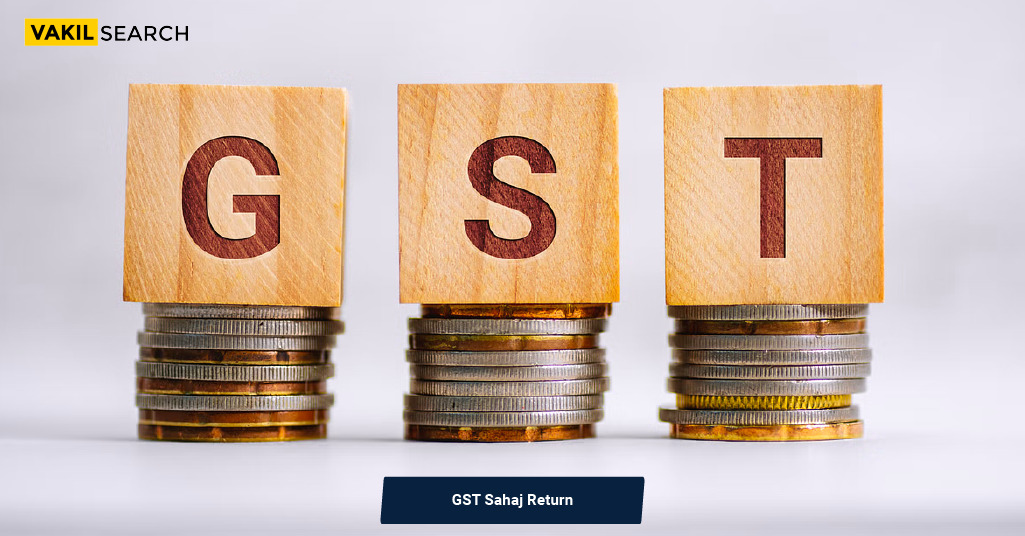GST Sahaj Return is a simplified filing option, ideal for small businesses. Understanding its advantages, eligibility criteria, and compliance requirements is essential for simplified and efficient tax filing under GST.
Sahaj Return in GST
Sahaj return is a simplified quarterly GST return form introduced by the Goods and Services Tax Council (GSTC) to ease the compliance burden for small taxpayers with a turnover of up to Rs. 5 crores per annum. It is an optional return filing option that eliminates the need to file detailed tax returns, making it more convenient for businesses with limited transactions.
Applicability of Sahaj Return
The Sahaj return is applicable to taxpayers who meet the following criteria,
- Turnover Limit: Aggregate turnover in the previous financial year should not exceed Rs. 5 crores.
- Nature of Supplies: Outward supplies should primarily be of a B2C nature, meaning supplies made to end consumers or unregistered businesses.
- Optional Filing: Sahaj return is an optional filing method. Taxpayers can choose to file either Sahaj return, Sugam return, or Quarterly return based on their convenience and compliance requirements.
Due Date to File Sahaj GST Return
The due date for filing Sahaj GST return is the last day of the month following the quarter for which the return is being filed:
| Quarter | Due Date |
| April-June | July 31st |
| July-September | October 31st |
| October-December | January 31st |
| January-March | April 30th |
Eligibility to File GST Return Sahaj
Taxpayers who meet the following criteria are eligible to file Sahaj GST return:
- Registered under GST with a valid GSTIN.
- Turnover in the previous financial year does not exceed Rs. 5 crores.
- Primarily engaged in B2C supplies.
- Not involved in exports, imports, or supplies to registered businesses.
Sahaj Return Filing Process
The Sahaj GST return filing process is relatively straightforward and can be completed online through the GST portal. Here’s a step-by-step guide:
- Login to GST Portal: Access the GST portal using your GSTIN and credentials.
- Navigate to the Returns Section: Locate the ‘Returns’ section and select ‘Quarterly Returns’.
- Choose Return Type: Select ‘Form GST RET-2’ for Sahaj return.
- Enter Quarter Details: Specify the quarter for which you are filing the return.
- Fill in Return Details: Provide the required information, including details of outward supplies, inward supplies with reverse charge, input tax credit (ITC), tax payable, and interest, if applicable.
- Upload Annexures: Upload the required annexures, including Form GST ANX-1 for outward supplies and inward supplies with reverse charge, and Form GST ANX-2 for auto-drafted inward supplies.
- Review and Submit: Review the entered details and annexures carefully. Once satisfied, submit the return.
- Make Tax Payment: Make the required tax payment through Challan 280.
Who Can File GSTR Sahaj?
GSTR SAHAJ can be filed by taxpayers who meet the following criteria:
- Registered under GST with a valid GSTIN.
- Turnover in the previous financial year does not exceed Rs. 5 crores.
- Primarily engaged in B2C supplies.
- Not involved in exports, imports, or supplies to registered businesses.
Invoice Upload System Under GSTR Sahaj
The Sahaj return form does not require taxpayers to upload individual invoices. Instead, it utilizes an auto-population feature that retrieves invoice details from the GST portal’s e-invoicing system. Taxpayers can reconcile these auto-populated details with their own records to ensure accuracy.
GST Return Sahaj Format
The Sahaj return is a simplified one-page summary return that captures essential GST-related information for the quarter. It consists of the following sections:
- Taxpayer Details: Basic information about the taxpayer, including GSTIN, legal name, and address.
- Outward Supplies: Details of outward supplies made during the quarter, including taxable value, tax rate, and tax amount.
- Inward Supplies with Reverse Charge: Details of inward supplies where reverse charge is applicable, including taxable value, tax rate, and tax amount.
- Interest on Late Tax Payment: Details of any interest payable on delayed tax payment.
- Tax Payment Details: Details of tax payment made, including challan number, date of payment, and amount paid.
What Are the Contents of GSTR Sahaj?
The contents of GSTR SAHAJ are as follows:
- Taxpayer details: GSTIN, legal name, address
- Outward supplies: Taxable value, tax rate, tax amount
- Inward supplies with reverse charge: Taxable value, tax rate, tax amount
- Interest on late tax payment: Details of any interest payable on delayed tax payment
- Tax payment details: Details of tax payment made, including challan number, date of payment, and amount paid
When Must GST Sahaj Be Filed?
GSTR SAHAJ must be filed by the last day of the month following the quarter for which the return is being filed. For example, the due date for filing the GSTR SAHAJ for the quarter of April to June is July 31st.
How to Differentiate Between Sahaj, Sugam, and Quarterly Returns?
Here is a table that summarizes the key differences between SAHAJ, SUGAM, and Quarterly returns:
| Feature | SAHAJ | SUGAM | Quarterly |
| Turnover limit | Up to Rs. 5 crores | Up to Rs. 5 crores | Up to Rs. 40 crores |
| Nature of supplies | Primarily B2C | B2C and B2B | B2C, B2B, exports, and imports |
| Return frequency | Quarterly | Quarterly | Quarterly or monthly |
| Return format | Simplified one-page summary | Simplified two-page summary | Detailed multi-page return |
| Invoice upload | Not required | Not required | Required for B2B supplies |
| Eligibility | Taxpayers with limited transactions and primarily B2C supplies | Taxpayers with moderate transactions and both B2C and B2B supplies | Taxpayers with higher turnover or involvement in exports, imports, or B2B supplies |
Switching from SAHAJ Return
Taxpayers who are currently filing GSTR SAHAJ can switch to SUGAM or Quarterly returns at any time. However, they cannot switch back to SAHAJ once they have opted for SUGAM or Quarterly returns.
To switch from SAHAJ to SUGAM or Quarterly returns, taxpayers can follow these steps:
- Login to the GST portal using their GSTIN and credentials.
- Navigate to the ‘Returns’ section and select ‘Quarterly Returns’.
- Choose the ‘Change Filing Frequency’ option.
- Select the desired return frequency (SUGAM or Quarterly).
- Submit the request.
Once the request is processed, the taxpayer will be able to file SUGAM or Quarterly returns from the next quarter onwards.
GST Sahaj Return FAQs
What is GST Sahaj return?
GST Sahaj return is a simplified quarterly GST return form introduced by the Goods and Services Tax Council (GSTC) for small taxpayers with a turnover of up to Rs. 5 crores per annum. It is an optional return filing method that eliminates the need to file detailed tax returns, making it more convenient for businesses with limited transactions.
Who can file GST Sahaj return?
Taxpayers who meet the following criteria can file GST Sahaj return:
- Registered under GST with a valid GSTIN.
- Aggregate turnover in the previous financial year does not exceed Rs. 5 crores.
- Primarily engaged in B2C supplies (supplies made to end consumers or unregistered businesses).
- Not involved in exports, imports, or supplies to registered businesses.
What are the benefits of filing GST Sahaj return?
The benefits of filing GST Sahaj return include:
- Simplified return format: The one-page summary format makes it easier to understand and fill out.
- Reduced compliance burden: Eliminates the need to file detailed returns, saving time and effort.
- Auto-populated invoice details: Retrieves invoice details from the e-invoicing system, reducing manual data entry.
- Convenience for small businesses: Tailored for taxpayers with limited transactions and primarily B2C supplies.
What is the frequency of GST Sahaj return filing?
GST Sahaj return is filed on a quarterly basis. The due date for filing the return is the last day of the month following the quarter for which the return is being filed.
Can I claim Input Tax Credit (ITC) when filing GST Sahaj return?
Yes, taxpayers can claim Input Tax Credit (ITC) when filing GST Sahaj return. The ITC is a credit that taxpayers can avail against the tax paid on their purchases.
Are there any penalties for late filing of GST Sahaj return?
Yes, there are penalties for late filing of GST Sahaj return. The late filing fee is Rs. 100 per day, subject to a maximum of Rs. 5,000.
How do I file GST Sahaj return online?
To file GST Sahaj return online, follow these steps:
- Login to the GST portal using your GSTIN and credentials.
- Navigate to the 'Returns' section and select 'Quarterly Returns'.
- Choose 'Form GST RET-2' for Sahaj return.
- Enter Quarter Details: Specify the quarter for which you are filing the return.
- Fill in Return Details: Provide the required information, including details of outward supplies, inward supplies with reverse charge, input tax credit (ITC), tax payable, and interest, if applicable.
- Upload Annexures: Upload the required annexures, including Form GST ANX-1 for outward supplies and inward supplies with reverse charge, and Form GST ANX-2 for auto-drafted inward supplies.
- Review and Submit: Review the entered details and annexures carefully. Once satisfied, submit the return.
- Make Tax Payment: Make the required tax payment through Challan 280.
Can I switch from Sahaj to other GST return schemes if my business grows?
Yes, taxpayers can switch from Sahaj to SUGAM or Quarterly returns at any time if their turnover exceeds Rs. 5 crores or they start making B2B supplies. However, they cannot switch back to SAHAJ once they have opted for SUGAM or Quarterly returns.
Is GST Sahaj return mandatory for eligible taxpayers?
No, GST Sahaj return is an optional filing method. Eligible taxpayers can choose to file either Sahaj return, Sugam return, or Quarterly return based on their convenience and compliance requirements.










